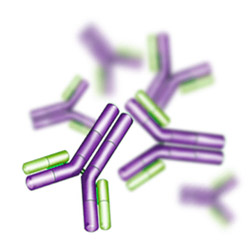Multitasking Antibody
We learned in high school and/or undergrad biology that one antibody would bind to one antigen. This is what makes our immune system so effective: antibodies bind with high affinity to foreign proteins or other molecules. Not only that, but those antibodies are specific: they would bind only to a specific site on the foreign protein (epitope) and fitting in it like a key in a lock. They business end of the key (antibody) is called the paratope.
A group at Genentech designed an antibody whose paratope binds two completely different targets. Human epidermal growth factor 2 (HER2) and Vascular Endothelial Growth Factor (VEGF). Both proteins are cancer therapy targets, and both are targets of antibody therapy of two different engineered antibodies. Jenny Bostrom and her colleagues at Genentech have designed one antibody that binds both proteins. They used a phage display library starting from a HER2- binding antibody, and screened for an antibody that maintained HER2 binding, but in addition bound VEGF. Both proteins were bound with a high affinity. They actually bind competitively to the binding site, so the antibody cannot bind both VEGF and HER2, only one or the other.
Why bother doing that if we already have two antibodies, each binding its target epitope with a hight affinity? For therapeutic purposes, it is better to dose with one antibody than with a combination therapy. Combination therapies can be expensive, and their outcomes are unclear; sometimes the clinical outcome could be worse.
One interesting question this study raises is an evolutionary one. Could such antibodies exist naturally? Could we have evolved antibodies that bind two completely different epitopes? When we use antibodies in the lab, we tend to screen against those that are promiscuous: bind more than one epitope. But maybe such antibodies do exist? I’ll admit I am less than well-versed in immunology, so anyone who knows anything about this is welcome to comment. Would such antibodies increase their organsm’s fitness? We do know that one line of the body’s defence against against cancer is immunological, so could we have a mechanism generating such “two-for-one” antibodies against cancer, or pathogens?
Bostrom, J., Yu, S., Kan, D., Appleton, B., Lee, C., Billeci, K., Man, W., Peale, F., Ross, S., Wiesmann, C., & Fuh, G. (2009). Variants of the Antibody Herceptin That Interact with HER2 and VEGF at the Antigen Binding Site Science, 323 (5921), 1610-1614 DOI: 10.1126/science.1165480




















Interesting…
It reminded me of a related paper from Dan Tawfik’s group:
“Antibody multispecificity mediated by conformational diversity.” Science. 2003 Feb 28;299(5611):1362-7.
http://www.sciencemag.org/cgi/content/abstract/299/5611/1362
Yeah, I’ve thought about this too. I met Rob Aalberse recently; his group have shown that IgG4 can swap heavy chains quite readily in the presence of a mild reducing agent – this is actually a potential risk for monoclonal antibody therapies that have IgG4 heavy chains (i.e. under the right conditions, could they swap heavy chains with an endogenous IgG4 & produce a self-reactive bi-specific antibody?). IgG4 can probably only do it because of particularly reduction-sensitive hinge region disulfides between the heavy chains – the other isotypes dont seem to be able to do it. Anyhoo, as interesting as it is, it just simply doesnt look like nature has made use of the phenomenon. Beyond the ability to produce an antibody that cannot cross-link Fc receptors, so is anti-inflammatory (although IgG4 sort of does this already by a different method: lack of receptor binding) I’m not sure what the big benefit would be….? (if you’re thinking of the ability to cross-link two antigens, say, there are far more specific ways to do it than relying on the ‘right’ two heavy chains recombining – I think it just isn’t specific enough to be useful for this in vivo).